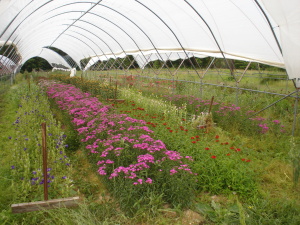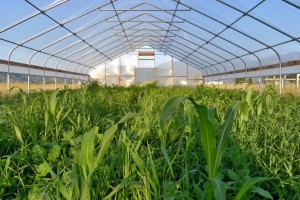High tunnels are unheated, plastic-covered structures that provide an intermediate level of environmental protection and control compared to open field conditions and heated greenhouses
 Cost
Cost
- Unlike commercial greenhouses that cost up to $20 per square foot to construct, high tunnels can cost as little as $0.50 per square foot
- Greenhouse structures may be covered with glass, rigid panels, or double-layers of plastic, but high tunnels are usually covered with a single layer of plastic
Dimensions
- High tunnels are tall enough to walk-in comfortably and to grow tall, trellised crops such as tomatoes
- In contrast, low tunnels are too short to stand upright inside and cannot be used to produce some crops
- There are no standard dimensions for high tunnel sizes, but they typically fall within the ranges of 14-30 feet wide by 30-96 feet long
Environmental Control
- Most high tunnels are passively ventilated via roll-up sidewalls and end walls that can be opened or removed
- Crops generally require no heat, though supplementary heat can be provided for protection on cold nights or used to extend the season even longer
 Row covers used within high tunnels provide additional protection from cold temperatures
Row covers used within high tunnels provide additional protection from cold temperatures
- In general, a single layer (the poly on the high tunnel) provides one hardiness zone of protection, and a second (the row cover) will provide another zone of protection
- Crops grown in zone 5 with two layers of protection are approximately equivalent to zone 7 as far as winter hardiness in concerned.
Production System
- Crops are typically grown in ground beds within the high tunnel rather than in containers
- Crops grown in these ground beds must be irrigated because rain cannot enter the protective structure
- Some high tunnels are erected on skids so that the structure can be moved during the production cycle




